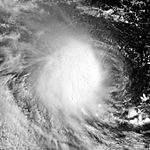1999–00 Australian region cyclone season
| 1999–2000 Australian region cyclone season |

Season summary map
|
| Seasonal boundaries |
| First system formed |
2 December 1999 |
| Last system dissipated |
23 May 2000 |
| Strongest storm |
|
| Name |
John and Paul |
| • Maximum winds |
205 km/h (125 mph)
(10-minute sustained) |
| • Lowest pressure |
915 hPa (mbar) |
|
| Seasonal statistics |
| Tropical lows |
14 |
| Tropical cyclones |
12 |
| Severe tropical cyclones |
5 |
| Total fatalities |
0 |
| Total damage |
Unknown |
| Related articles |
|
|
Australian region tropical cyclone seasons
1997–98, 1998–99, 1999–00, 2000–01, 2001–02
|
| Tropical low (Australian scale) |
|
|
| Duration |
2 December – 3 December |
| Peak intensity |
55 km/h (35 mph) (10-min) 1002 hPa (mbar) |
| Category 2 tropical cyclone (Australian scale) |
| Tropical storm (SSHWS) |
|
|
| Duration |
9 December – 17 December |
| Peak intensity |
100 km/h (60 mph) (10-min) 980 hPa (mbar) |
| Category 5 severe tropical cyclone (Australian scale) |
| Category 4 tropical cyclone (SSHWS) |
|
|
| Duration |
9 December – 16 December |
| Peak intensity |
215 km/h (130 mph) (10-min) 915 hPa (mbar) |
| Category 2 tropical cyclone (Australian scale) |
| Category 2 tropical cyclone (SSHWS) |
|
|
| Duration |
24 January – 2 February |
| Peak intensity |
110 km/h (70 mph) (10-min) 975 hPa (mbar) |
| Category 3 severe tropical cyclone (Australian scale) |
| Category 1 tropical cyclone (SSHWS) |
|
|
| Duration |
1 February – 8 February (Crossed 90°E)
|
| Peak intensity |
140 km/h (85 mph) (10-min) 960 hPa (mbar) |
| Category 1 tropical cyclone (Australian scale) |
| Tropical storm (SSHWS) |
|
|
| Duration |
14 February – 18 February |
| Peak intensity |
65 km/h (40 mph) (10-min) 995 hPa (mbar) |
| Category 3 severe tropical cyclone (Australian scale) |
| Category 1 tropical cyclone (SSHWS) |
|
|
| Duration |
27 February – 11 March |
| Peak intensity |
150 km/h (95 mph) (10-min) 975 hPa (mbar) |
| Category 4 severe tropical cyclone (Australian scale) |
| Category 4 tropical cyclone (SSHWS) |
|
|
| Duration |
29 February – 9 March (Crossed 90°E)
|
| Peak intensity |
185 km/h (115 mph) (10-min) 930 hPa (mbar) |
| Category 2 tropical cyclone (Australian scale) |
| Tropical storm (SSHWS) |
|
|
| Duration |
15 March – 20 March |
| Peak intensity |
90 km/h (55 mph) (10-min) 985 hPa (mbar) |
The 1999–2000 Australian region cyclone season was a slightly above average tropical cyclone season. It ran from 1 November 1999 to 30 April 2000. The regional tropical cyclone operational plan also defines a "tropical cyclone year" separately from a "tropical cyclone season", with the "tropical cyclone year" for this season lasting from 1 July 1999 to 30 June 2000.
Two of the most notable cyclones of the season were Steve and Rosita. Cyclone Steve transversed the entire Australian continent, and although a fairly weak cyclone, caused widespread flooding in Queensland, Northern Territory and Western Australia, while Cyclone Rosita made an almost direct hit on Broome as a severe Category 4 cyclone, devastating several remote stations and the town itself. Rosita surprised many residents of its arrival, as it made landfall very late in the season.
Ilsa formed to the northeast of the Cocos Islands on 11 December 1999. The cyclone moved to the south of Christmas Island on the 13th producing a heavy swell which caused some damage. Its development was impeded by vertical windshear for a large part of its lifetime. After a long track eastwards across the Indian Ocean it eventually crossed the Western Australian coastline on the Eighty Mile Beach near the Sandfire Roadhouse during the early afternoon of 17 December 1999. Apart from producing heavy rainfall, Ilsa did not produce any significant damage.
Tropical Cyclone John started as a low to the south-west of Timor on 9 December 1999. It rapidly intensified and moved towards the Pilbara coast of Western Australia. Just before landfall it was a severe category 5 storm with a central pressure of 915 hPa, with winds estimated at being up to 290 km/h (180 mph). The cyclone crossed the coast just to the west of Whim Creek between Port Hedland and Karratha on 8:30 am (WST) 15 December 1999. At the time of coastal crossing, it was estimated to have a central pressure between 930 and 940 hPa. The cyclone moved inland before dissipating the next day.
...
Wikipedia


















